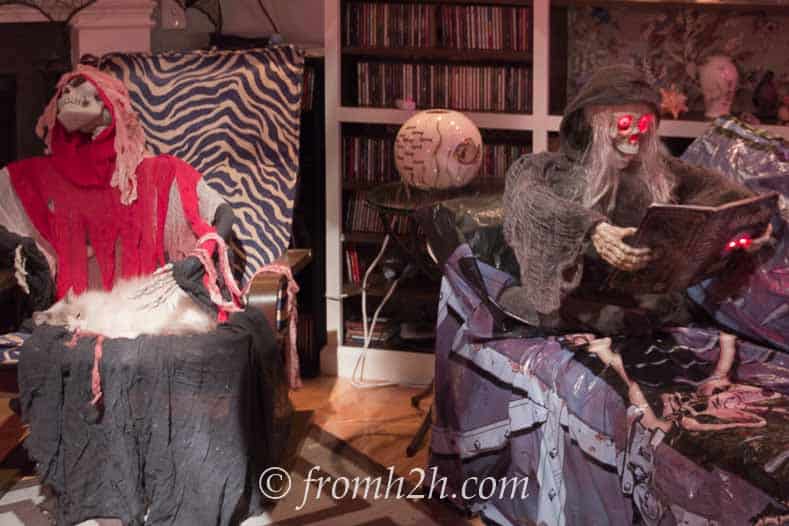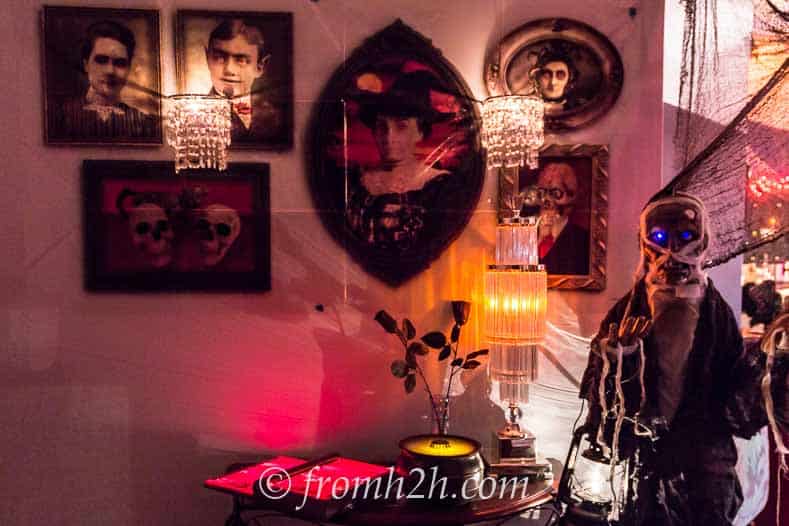How to use Halloween props

Indoor props usually look best if you can integrate them into the room naturally–either by coming up with a vignette that you are staging, or by having the props “mingle” with your guests. In the picture above, the skeletons are making themselves at home–one by reading an animated, scary book on the sofa, and the other taking a snooze on the chair (this one looks so comfortable that Chanel, the family cat joined him…and yes, the cat is real!).
You can buy just about any kind of Halloween prop you can think of, and at many different price points. Most of the easily-available props are fairly inexpensive in both price and quality. However, because you are using them only once a year, and most things are seen in dim light, the lack of quality isn’t usually that much of an issue.
If you are using props, many of them have eyes that glow or flash, or have lighted “fake” flames, or light up as part of their animation. Use these in a somewhat dark area for the best effect. I often like to set up a scene in the front entry way that “welcomes” guests and shows off a few of these props. It sets the tone for the party, and at this point you have a captive audience who will notice and appreciate your handiwork…once inside, props sometimes go unnoticed as people are too busy socializing.

In the picture, a standing skeleton in the background has eyes that glow, an animated spell book glows in the foreground, and a cauldron with a mister adds to the front-entry ambiance. The sconces hold tea-light candles, and the bulb in the lamp has been replaced by a flicker light bulb. Scene setters provide the scary halloween pictures on the wall.
Animated props, that move, talk or light up when someone walks by are always a big hit with guests. There are a few different mechanisms that are used to trigger these actions so you will want to know which kind will work best for your scene:
- A sound sensor will start the animation if a noise is made nearby. These work well in areas where there is not a lot of background noise…if you have the prop in your main room where the music is playing, it will be going off all night long, which maybe what you want, but if you’re looking for the element of surprise, this won’t work. I like to put these kinds of props in rooms like the bathroom, which are usually a little out of the way but still used frequently.
- A motion sensor will start the animation if the sensor detects something moving nearby. These work well in areas where there is a fair amount of light (so that the sensor can detect the motion), and where people are walking by. The front walk-way or entrance is usually a good place for props with this type of sensor, since everyone will be walking by and there is usually enough light for the sensor to work.
- A pressure sensor is triggered when someone steps on it or presses it. These are a reliable way to trigger your animation if they are in a location where people are walking (or leaning to see one of your other scenes). Since it doesn’t depend on light like the motion sensors do, they can be placed anywhere. I like to have a scene behind a fence with a sensor on the fence that causes a spider or bat to drop when someone leans in to take a look…definitely a surprise!
One word of caution: It is very easy to go over board with the props (there are so many fun options to choose from!) but remember that you need to be able to store them after Halloween is over, so make sure you have enough room for them in your attic or garage.
This post was originally published on September 17, 2014 but was updated with new content on November 1, 2023.
